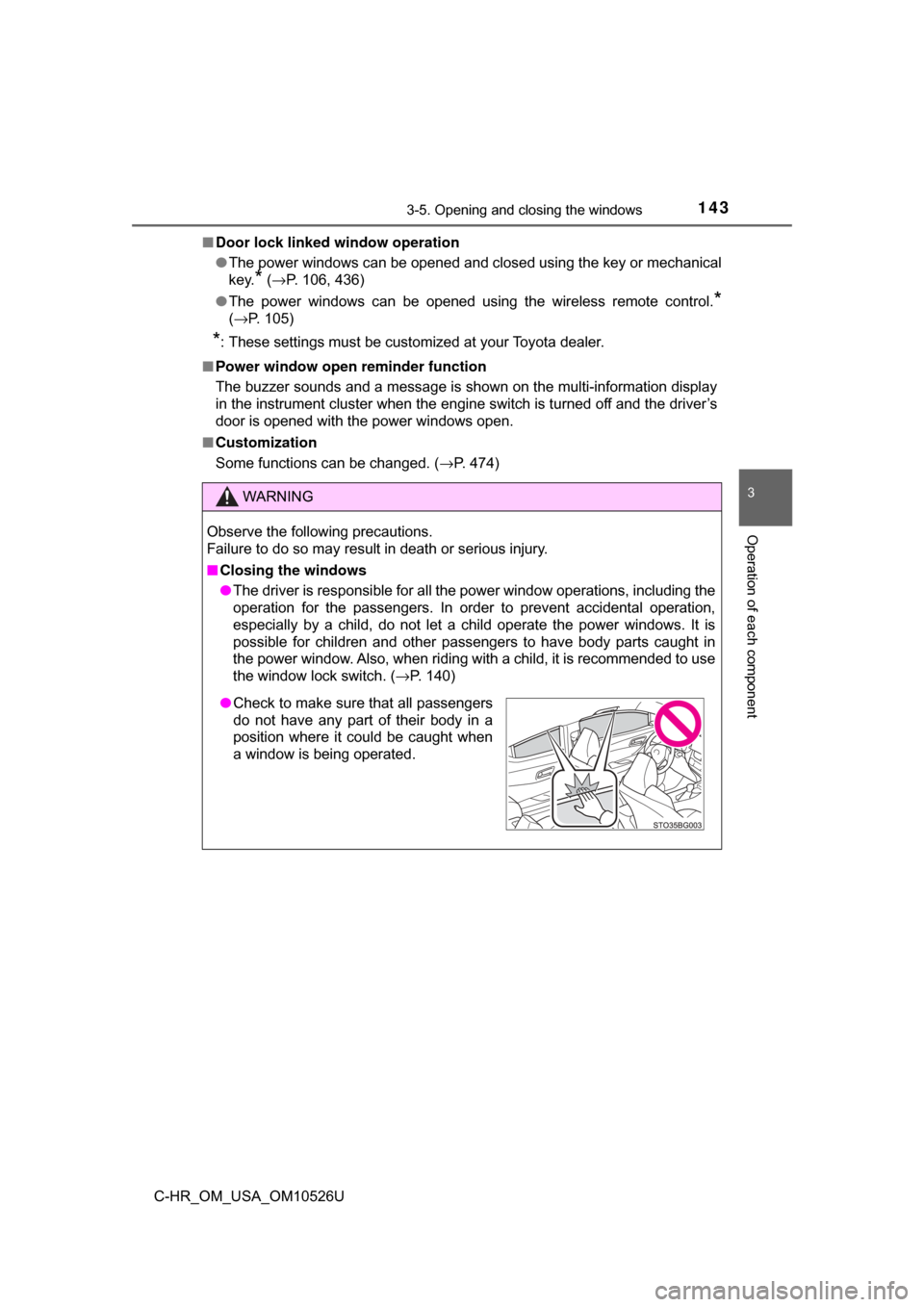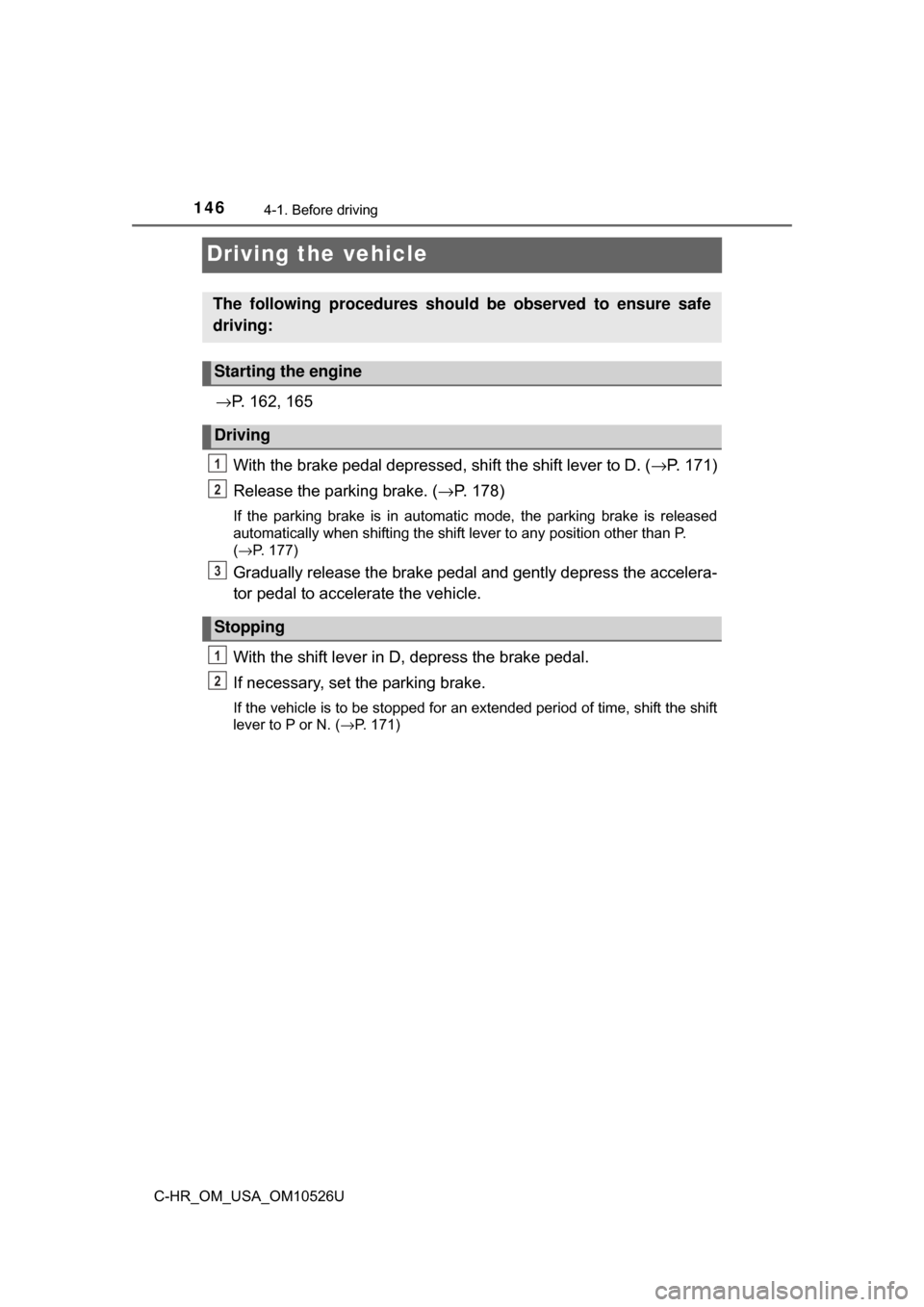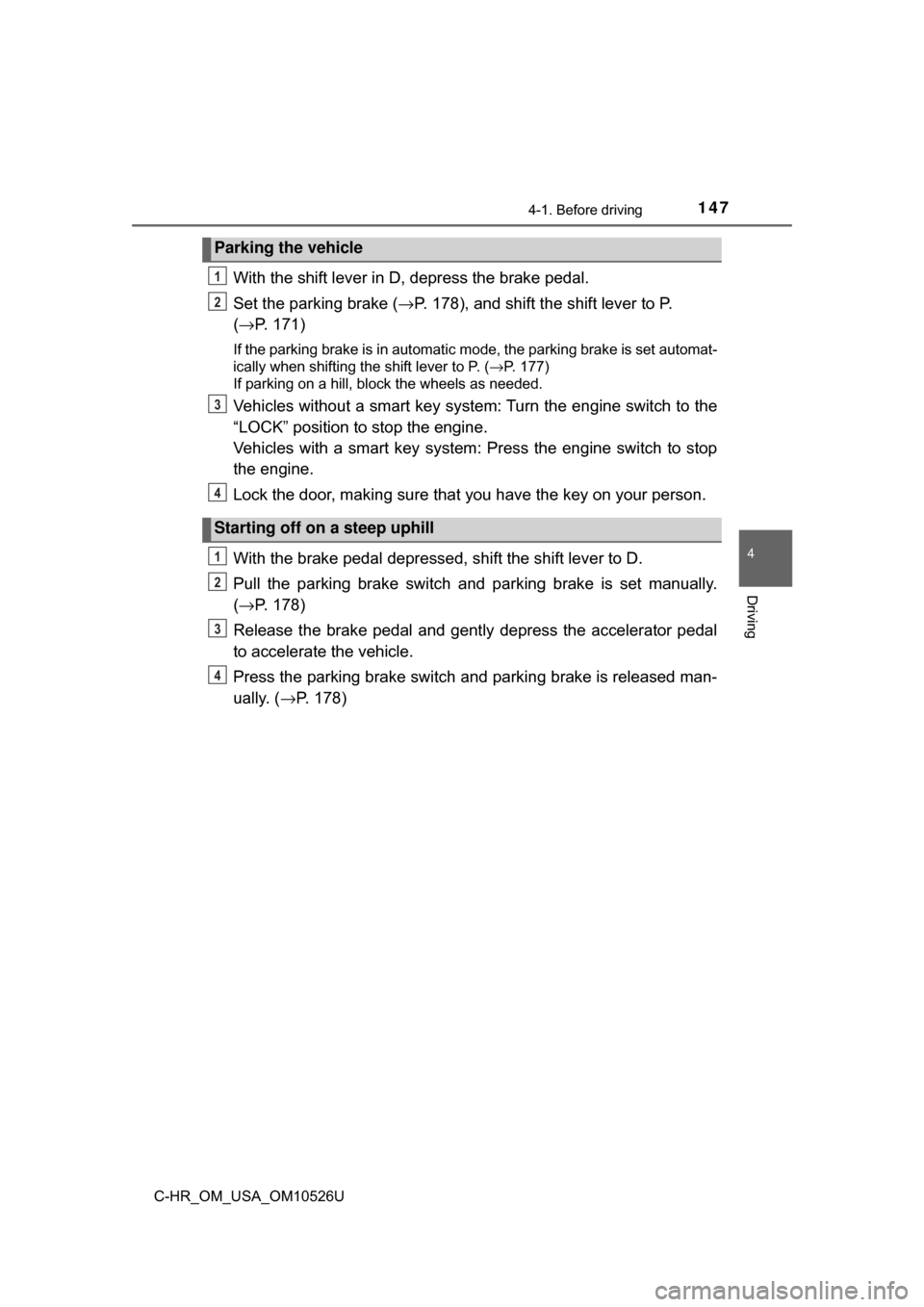TOYOTA C-HR 2018 1.G Owners Manual
Manufacturer: TOYOTA, Model Year: 2018, Model line: C-HR, Model: TOYOTA C-HR 2018 1.GPages: 516, PDF Size: 9.32 MB
Page 141 of 516

1413-5. Opening and closing the windows
3
Operation of each component
C-HR_OM_USA_OM10526U
■The power windows can be operated when
Vehicles without a smart key system:
The engine switch is in the “ON” position.
Vehicles with a smart key system:
The engine switch is in IGNITION ON mode.
■ Operating the power windows a fter turning the engine off
Vehicles without a smart key system:
The power windows can be operated for approximately 45 seconds after the
engine switch is turned to the “ACC” or “LOCK” position. They cannot, how-
ever, be operated once either front door is opened.
Vehicles with a smart key system:
The power windows can be operated for approximately 45 seconds after the
engine switch is turned to ACCESSORY mode or turned off. They cannot,
however, be operated once either front door is opened.
■ Jam protection function
If an object becomes jammed between the side window and the window
frame while the side window is closing, side window movement is stopped
and the side window is opened slightly.
■ Catch protection function
If an object becomes caught between the door and side window while the
side window is opening, side window movement is stopped.
Page 142 of 516

1423-5. Opening and closing the windows
C-HR_OM_USA_OM10526U■
When the side window canno t be opened or closed
When the jam protection function or catch protection function operates
unusually and the side window cannot be opened or closed, perform the fol-
lowing operations with the power window switch of that door.
● Stop the vehicle. With the engine switch is in the “ON” position (vehicles
without a smart key system) or IGNITION ON mode (vehicles with a smart
key system), within 4 seconds of the jam protection function or catch protec-
tion function activating, continuously operate the power window switch in
the one-touch closing direction or one-touch opening direction so that the
side window can be opened and closed.
● If the side window cannot be opened and closed even when performing the
above operations, perform the following procedure for function initialization.
Turn the engine switch to the “ON” position (vehicles without a smart key
system) or IGNITION ON mode (vehicles with a smart key system).
Pull and hold the power window switch in the one-touch closing direction
and completely close the side window.
Release the power window switch for a moment, resume pulling the
switch in the one-touch closing direction, and hold it there for approxi-
mately 6 seconds or more.
Press and hold the power window switch in the one-touch opening direc-
tion. After the side window is completely opened, continue holding the
switch for an additional 1 second or more.
Release the power window switch for a moment, resume pushing the
switch in the one-touch opening direction, and hold it there for approxi-
mately 4 seconds or more.
Pull and hold the power window switch in the one-touch closing direction
again. After the side window is completely closed, continue holding the
switch for a further 1 second or more.
If you release the switch while the window is moving, start again from t\
he
beginning. If the window reverses and cannot be fully closed or opened, have
the vehicle inspected by your Toyota dealer.
1
2
3
4
5
6
Page 143 of 516

1433-5. Opening and closing the windows
3
Operation of each component
C-HR_OM_USA_OM10526U■
Door lock linked window operation
●The power windows can be opened and closed using the key or mechanical
key.
* (→P. 106, 436)
● The power windows can be opened using the wireless remote control.
*
(→P. 105)
*: These settings must be customized at your Toyota dealer.
■ Power window open reminder function
The buzzer sounds and a message is shown on the multi-information display
in the instrument cluster when the engine switch is turned off and the driver’s
door is opened with the power windows open.
■ Customization
Some functions can be changed. ( →P. 474)
WARNING
Observe the following precautions.
Failure to do so may result in death or serious injury.
■Closing the windows
● The driver is responsible for all the power window operations, including the
operation for the passengers. In order to prevent accidental operation,
especially by a child, do not let a child operate the power windows. It is
possible for children and other passengers to have body parts caught in
the power window. Also, when riding with a child, it is recommended to use
the window lock switch. ( →P. 140)
●Check to make sure that all passengers
do not have any part of their body in a
position where it could be caught when
a window is being operated.
Page 144 of 516

1443-5. Opening and closing the windows
C-HR_OM_USA_OM10526U
WARNING
Observe the following precautions.
Failure to do so may result in death or serious injury.
■Closing the windows
● When using the wireless remote control, key or mechanical key ( →P. 98)
and operating the power windows, operate the power window after check-
ing to make sure that there is no possibility of any passenger having any of
their body parts caught in the side window. Also do not let a child operate
side window by the wireless remote control, key or mechanical key. It is
possible for children and other passengers to get caught in the power win-
dow.
● When exiting the vehicle, turn the engine switch off, carry the key and exit
the vehicle along with the child. There may be accidental operation, due to
mischief, etc., that may possibly lead to an accident.
■ Jam protection function
● Never use any part of your body to intentionally activate the jam protection
function.
● The jam protection function may not work if something gets jammed just
before the side window is fully closed. Be careful not to get any part of
your body jammed in the side window.
■ Catch protection function
● Never use any part of your body or clothing to intentionally activate the
catch protection function.
● The catch protection function may not work if something gets caught just
before the side window is fully opened. Be careful not to get any part of
your body or clothing caught in the side window.
Page 145 of 516

145
4Driving
C-HR_OM_USA_OM10526U4-1. Before driving
Driving the vehicle ............. 146
Cargo and luggage ........... 156
Vehicle load limits ............. 159
Trailer towing..................... 160
Dinghy towing ................... 161
4-2. Driving procedures Engine (ignition) switch (vehicles without
a smart key system) ........ 162
Engine (ignition) switch (vehicles with
a smart key system) ........ 165
Continuously variable transmission .................... 171
Turn signal lever................ 176
Parking brake .................... 177
Brake Hold ........................ 182
4-3. Operating the lights and wipers
Headlight switch ................ 185
Automatic High Beam ....... 190
Windshield wipers and washer ............................ 195
Rear window wiper and washer ............................ 198 4-4. Refueling
Opening the fuel tank cap .................................. 200
4-5. Using the driving support systems
Toyota Safety Sense P ..... 204
PCS (Pre-Collision System)........................... 211
LDA (Lane Departure Alert with steering
control) ............................ 226
Dynamic radar cruise control with full-speed
range............................... 236
Driving mode select .......... 251
BSM (Blind Spot Monitor) ........ 253
• BSM function ................ 258
• RCTA function .............. 263
Rear view monitor system ............................ 268
Driving assist systems ...... 279
4-6. Driving tips Winter driving tips ............. 285
Page 146 of 516

1464-1. Before driving
C-HR_OM_USA_OM10526U
Driving the vehicle
→P. 162, 165
With the brake pedal depressed, shift the shift lever to D. ( →P. 171)
Release the parking brake. ( →P. 178)
If the parking brake is in automatic mode, the parking brake is released
automatically when shifting the shift lever to any position other than P.
(→P. 177)
Gradually release the brake pedal and gently depress the accelera-
tor pedal to accelerate the vehicle.
With the shift lever in D, depress the brake pedal.
If necessary, set the parking brake.
If the vehicle is to be stopped for an extended period of time, shift the shift
lever to P or N. ( →P. 171)
The following procedures should be observed to ensure safe
driving:
Starting the engine
Driving
Stopping
1
2
3
1
2
Page 147 of 516

1474-1. Before driving
4
Driving
C-HR_OM_USA_OM10526U
With the shift lever in D, depress the brake pedal.
Set the parking brake (→P. 178), and shift the shift lever to P.
( → P. 171)
If the parking brake is in automatic mode, the parking brake is set automat-
ically when shifting the shift lever to P. ( →P. 177)
If parking on a hill, block the wheels as needed.
Vehicles without a smart key system: Turn the engine switch to the
“LOCK” position to stop the engine.
Vehicles with a smart key system : Press the engine switch to stop
the engine.
Lock the door, making sure that you have the key on your person.
With the brake pedal depressed, shift the shift lever to D.
Pull the parking brake switch and parking brake is set manually.
( → P. 178)
Release the brake pedal and gently depress the accelerator pedal
to accelerate the vehicle.
Press the parking brake switch and parking brake is released man-
ually. ( →P. 178)
Parking the vehicle
Starting off on a steep uphill
1
2
3
4
1
2
3
4
Page 148 of 516

1484-1. Before driving
C-HR_OM_USA_OM10526U
■When starting off on an uphill
The hill-start assist control will activate. ( →P. 279)
■ Driving in the rain
●Drive carefully when it is raining, because visibility will be reduced, the win-
dows may become fogged-up, and the road will be slippery.
● Drive carefully when it starts to rain, because the road surface will be espe-
cially slippery.
● Refrain from high speeds when driving on an expressway in the rain,
because there may be a layer of water between the tires and the road sur-
face, preventing the steering and brakes from operating properly.
■ Engine speed while driving
In the following conditions, the engine speed may become high while driving.
This is due to automatic up-shifting control or down-shifting implementation to
meet driving conditions. It does not indicate sudden acceleration.
●The vehicle is judged to be driving uphill or downhill
● When the accelerator pedal is released
● When the brake pedal is depressed while sport mode is selected
● When the brake pedal is depressed suddenly and vehicle speed is reduced
sharply
■ Restraining the engine output (Brake Override System)
● When the accelerator and brake pedals are depressed at the same time, the
engine output may be restrained.
● A warning message is displayed on the multi-information display while the
system is operating.
■ Restraining sudden star t (Drive-Start Control)
● When the following unusual operation is performed, the engine output may
be restrained.
• When the shift lever is shifted from R to D, D to R, N to R, P to D, or P to
R (D includes M) with the accelerator pedal depressed, a warning mes-
sage appears on the multi-information display.
• When the accelerator pedal is depressed too much while the vehicle is in reverse.
● While Drive-Start Control is being activated, your vehicle may have trouble
escaping from the mud or fresh snow. In such case, deactivate TRAC to
cancel Drive-Start Control so that the vehicle may become able to escape
from the mud or fresh snow.
Page 149 of 516

1494-1. Before driving
4
Driving
C-HR_OM_USA_OM10526U■
Breaking in your new Toyota
To extend the life of the vehicle, observing the following precautions is recom-
mended:
●For the first 186 miles (300 km):
Avoid sudden stops.
● For the first 621 miles (1000 km):
• Do not drive at extremely high speeds.
• Avoid sudden acceleration.
• Do not drive continuously in low gears.
• Do not drive at a constant speed for extended periods.
■ Operating your vehicle in a foreign country
Comply with the relevant vehicle registration laws and confirm the availability
of the correct fuel. ( →P. 452)
WARNING
Observe the following precautions.
Failure to do so may result in death or serious injury.
■When starting the vehicle
Always keep your foot on the brake pedal while stopped with the engine
running. This prevents the vehicle from creeping.
Page 150 of 516

1504-1. Before driving
C-HR_OM_USA_OM10526U
WARNING
Observe the following precautions.
Failure to do so may result in death or serious injury.
■When driving the vehicle
● Do not drive if you are unfamiliar with the location of the brake and ac\
cel-
erator pedals to avoid depressing the wrong pedal.
• Accidentally depressing the accelerator pedal instead of the brake
pedal will result in sudden acceleration that may lead to an accident.
• When backing up, you may twist your body around, leading to a diffi- culty in operating the pedals. Make sure to operate the pedals properly.
• Make sure to keep a correct driving posture even when moving the
vehicle only slightly. This allows you to depress the brake and accelera-
tor pedals properly.
• Depress the brake pedal using your right foot. Depressing the brake
pedal using your left foot may delay response in an emergency, result-
ing in an accident.
● Do not drive the vehicle over or stop the vehicle near flammable materials.
The exhaust system and exhaust gases can be extremely hot. These hot
parts may cause a fire if there is any flammable material nearby.
● During normal driving, do not turn off the engine. Turning the engine off
while driving will not cause loss of steering or braking control, but the
power assist to these systems will be lost. This will make it more difficult to
steer and brake, so you should pull over and stop the vehicle as soon as it
is safe to do so.
However, in the event of an emergency, such as if it becomes impossible
to stop the vehicle in the normal way: →P. 397
● Use engine braking (downshift) to maintain a safe speed when driving
down a steep hill.
Using the brakes continuously may cause the brakes to overheat and lose
effectiveness. ( →P. 171)
● Do not adjust the display, the positions of the steering wheel, the seat, or
the inside or outside rear view mirrors while driving.
Doing so may result in a loss of vehicle control.
● Always check that all passengers’ arms, heads or other parts of their body
are not outside the vehicle.
● Do not drive in excess of the speed limit. Even if the legal speed limit per-
mits it, do not drive over 85 mph (140 km/h) unless your vehicle has h\
igh-
speed capability tires. Driving over 85 mph (140 km/h) may result in tire
failure, loss of control and possible injury. Be sure to consult a tire dealer
to determine whether the tires on your vehicle are high-speed capability
tires or not before driving at such speeds.